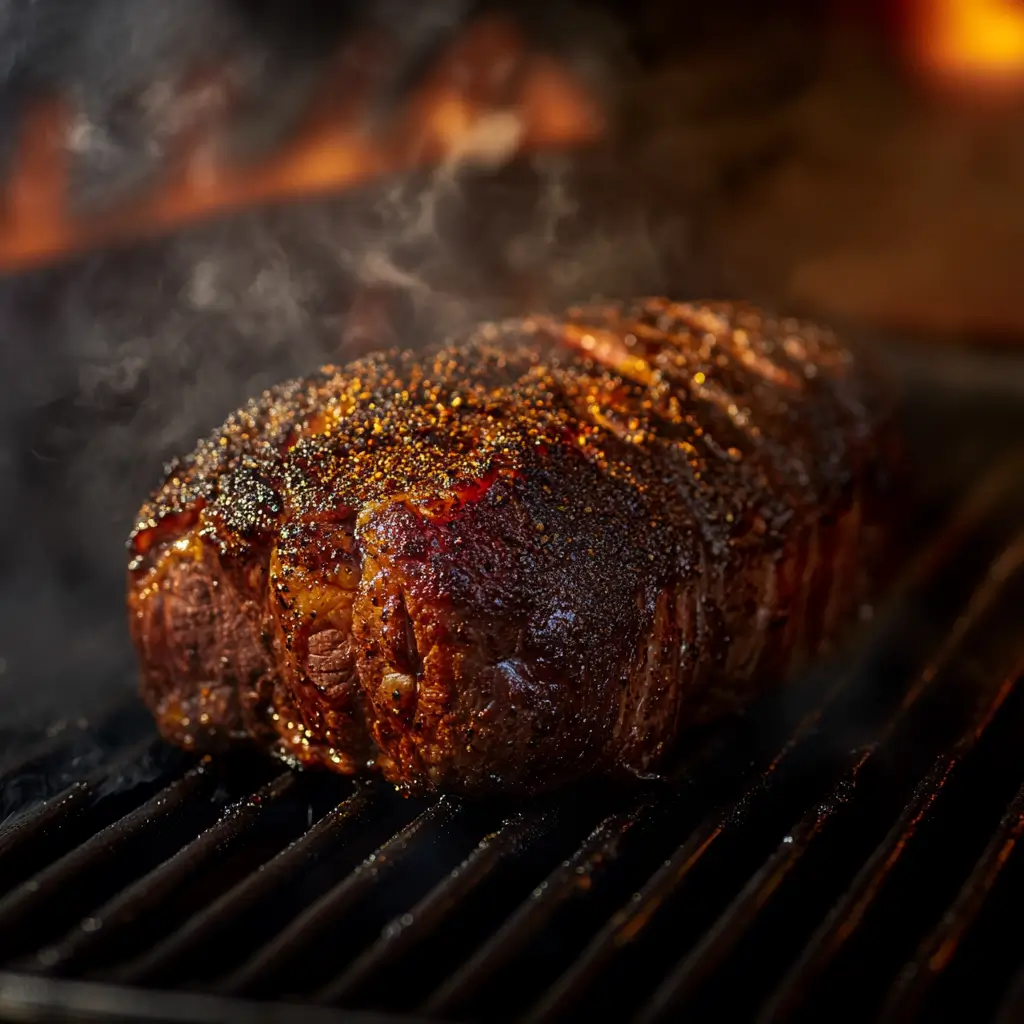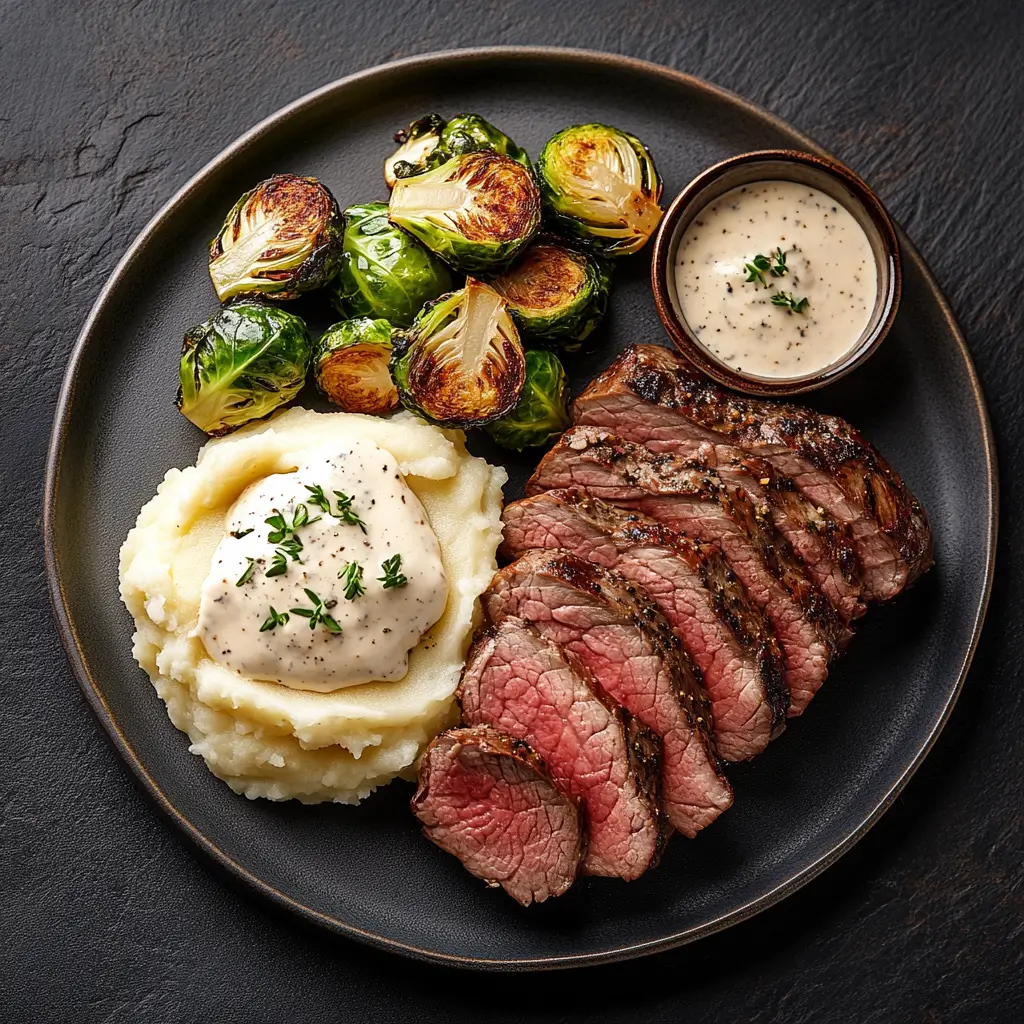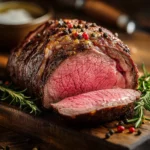Few dishes are as mouthwatering as a perfectly cooked prime rib. Its rich marbling, juicy tenderness, and deep beefy flavor make it a top choice for holiday feasts, special occasions, and steakhouse lovers alike. However, the hefty price tag of prime rib can make it an occasional indulgence rather than an everyday meal.
That’s where Poor Man’s Prime Rib comes in. By using a more affordable cut—such as chuck roast or top sirloin—you can recreate the flavor and texture of prime rib at a fraction of the cost. When seasoned properly and cooked low and slow, these alternative cuts transform into a tender, juicy roast that rivals the real thing.
In this guide, you’ll learn exactly how to make Poor Man’s Prime Rib, from choosing the best beef cut to mastering the cooking process step by step. Whether you’re preparing a Sunday dinner, a holiday meal, or just craving a hearty beef roast, this recipe will help you achieve steakhouse-quality results—without breaking the bank.
Table of Contents
What is Poor Man’s Prime Rib?
Poor Man’s Prime Rib is a budget-friendly alternative to traditional prime rib, made using a more affordable beef cut but cooked with the same slow-roasting techniques. The result? A flavor-packed, tender roast with a deliciously seasoned crust—just like the high-end version.
Although prime rib comes from the primal rib section of the cow, which is naturally well-marbled and tender, it’s also one of the most expensive cuts of beef. However, by selecting the right alternative cut and using a proper cooking method, you can achieve similar tenderness and depth of flavor without spending a fortune.
The Best Cuts for a Prime Rib Alternative
Selecting the right cut of beef is essential for making a successful Poor Man’s Prime Rib. Here are the best options:
1. Chuck Roast – The Top Choice
- Rich marbling gives it great flavor and tenderness when cooked low and slow.
- More affordable than prime rib, often costing less than half the price.
- Best cooked using slow-roasting or smoking methods to break down tough fibers.
2. Top Sirloin Roast – Lean but Tender
- Less marbled than chuck but still flavorful and juicy.
- A great choice for those who prefer leaner meat with less fat.
- Requires careful monitoring to prevent overcooking and drying out.
3. Eye of Round Roast – Budget-Friendly but Requires Extra Care
- The cheapest option, making it perfect for large gatherings on a budget.
- Very lean with little marbling, meaning it can dry out if overcooked.
- Best cooked low and slow with added fat (such as butter or beef tallow) to enhance juiciness.
Key Ingredients for Maximum Flavor
To replicate the rich, savory flavor of traditional prime rib, you need a simple but effective seasoning blend.
| Ingredient | Amount | Notes |
|---|---|---|
| Chuck Roast | 3-5 lbs | Preferred cut for flavor and tenderness |
| Kosher Salt | 2 tbsp | Essential for seasoning and moisture retention |
| Black Pepper | 1 tbsp | Creates a classic steakhouse-style crust |
| Garlic Powder | 1 tbsp | Adds depth and enhances umami flavors |
| Butter | 4 tbsp | Helps develop a golden-brown crust and adds richness |
| Olive Oil | 2 tbsp | Used for searing to lock in juices |
| Rosemary | 1 tsp | Provides a herbaceous, aromatic finish |
| Thyme | 1 tsp | Pairs well with beef’s natural flavors |
Step-by-Step Cooking Instructions
Achieving a perfectly cooked Poor Man’s Prime Rib requires proper preparation, a slow roasting method, and the right finishing touches. Follow these steps for restaurant-quality results.
1. Preparing the Roast
- Remove the roast from the refrigerator at least one hour before cooking. This step ensures even cooking and prevents the meat from seizing up in the oven.
- Pat the meat dry with paper towels—this helps create a better sear.
- Rub the roast generously with olive oil, salt, pepper, garlic powder, rosemary, and thyme. The olive oil helps the seasoning stick while creating a flavorful crust.
2. Searing for Maximum Flavor
- Preheat a cast-iron skillet over high heat and add 2 tbsp of olive oil.
- Sear the roast on all sides for 2-3 minutes per side. This step locks in juices and creates a flavorful crust.
- Once seared, transfer the roast to a wire rack placed over a baking sheet.
3. Slow Roasting for Tenderness
- Preheat your oven to 275°F (135°C)—a low temperature ensures even cooking.
- Insert a meat thermometer into the thickest part of the roast.
- Roast the beef until it reaches:
- 125°F for medium-rare
- 135°F for medium
- Cooking time varies but typically takes 1.5 to 2.5 hours.

4. Resting and Slicing the Roast
- Remove the roast from the oven and tent it loosely with foil.
- Let it rest for 20 minutes—this allows the juices to redistribute, preventing dryness.
- Slice against the grain for the most tender texture.
Alternative Cooking Methods for Poor Man’s Prime Rib
While oven-roasting is the classic method, there are other ways to cook Poor Man’s Prime Rib depending on your preferred texture and flavor.
How to Smoke a Poor Man’s Prime Rib
- Preheat your smoker to 225°F (107°C).
- Use hickory or mesquite wood chips for a deeper flavor.
- Smoke the roast for 2-3 hours, or until the internal temperature reaches 130°F.
- Let it rest before slicing to keep juices intact.
Slow Cooker Method for Extra Tenderness
- Place the seasoned roast in a slow cooker with beef broth and onions.
- Cook on low for 6-8 hours until fall-apart tender.
- Slice and serve with the cooking juices as au jus.
Pro Tips for the Best Poor Man’s Prime Rib
Even though Poor Man’s Prime Rib is a budget-friendly dish, small adjustments can elevate it to steakhouse quality. Follow these expert tips to maximize tenderness, flavor, and presentation.
1. Use a Meat Thermometer for Precision Cooking
A meat thermometer is essential for achieving the perfect doneness. Without it, you risk overcooking or undercooking your roast. Here’s how to use one effectively:
- Insert the thermometer into the thickest part of the roast, avoiding fat or bone.
- Monitor the internal temperature carefully and remove the roast at:
- 125°F (52°C) for medium-rare
- 135°F (57°C) for medium
- 145°F (63°C) for medium-well
- Keep in mind that the temperature will continue rising by 5-10°F during resting.
2. Reverse Sear for a Crispy Crust
A reverse sear creates a crispy, golden-brown crust while keeping the inside juicy and tender. To do this:
- Slow-roast at 275°F (135°C) until the meat reaches 10°F below your target doneness.
- Let the roast rest for 15 minutes.
- Sear it in a smoking-hot cast-iron skillet for 60 seconds per side.
3. Dry Brining for Maximum Flavor
For deeper flavor and better moisture retention, try dry brining:
- Season the roast liberally with salt and leave it uncovered in the fridge for 12-24 hours.
- This technique draws out moisture, allowing the salt to penetrate deeper into the meat.
- The result? A juicier, more flavorful roast with a beautifully crisp exterior.
4. Let the Meat Rest Before Slicing
One of the most overlooked steps is resting the roast before slicing. This ensures that the juices redistribute, keeping the meat moist and tender.
- Tent the roast with foil and let it rest for at least 20 minutes.
- Slice against the grain for the most tender bite possible.

Perfect Side Dishes for Poor Man’s Prime Rib
Although Poor Man’s Prime Rib is the star of the show, the right side dishes can take the meal to the next level.
Classic Comfort Sides
- Garlic Mashed Potatoes – Creamy, buttery, and the perfect pairing for rich beef.
- Yorkshire Pudding – A classic, airy side that soaks up juices beautifully.
- Roasted Brussels Sprouts – Crispy, caramelized, and a great contrast to the roast.
Lighter, Healthier Sides
- Steamed Asparagus – Bright, fresh, and a nice balance to the richness of the beef.
- Mixed Green Salad – Light and refreshing, with a tangy vinaigrette.
- Cauliflower Rice – A great low-carb alternative to potatoes.
Essential Sauces & Condiments
- Au Jus – A flavorful, savory sauce made from the pan drippings.
- Horseradish Cream Sauce – A zesty, creamy kick that complements the beef’s richness.
- Garlic Herb Butter – Melts into the meat, adding an extra layer of flavor.
FAQs
What is a cheap alternative to prime rib?
Chuck roast is the best budget-friendly substitute for prime rib due to its marbling and deep beefy flavor. Other alternatives include top sirloin roast (leaner but still tender) and eye of round roast (affordable but requires slow cooking to stay tender).
How to smoke a Poor Man’s Prime Rib?
Smoking adds a rich, smoky flavor to the roast. Follow these steps:
Preheat your smoker to 225°F (107°C).
Season the roast generously with salt, pepper, and garlic powder.
Use hickory or mesquite wood chips for the best flavor.
Smoke for 2-3 hours, or until the internal temperature reaches 130°F.
Rest before slicing to keep the juices inside.
What is the most tender roast other than prime rib?
Beef Tenderloin – The most tender cut, but expensive.
Chuck Roast – Becomes fall-apart tender when slow-cooked.
Top Sirloin Roast – Leaner but still tender when cooked properly.
Is prime rib better than ribeye?
Both come from the same primal cut, but they differ in preparation:
Prime rib is slow-roasted, making it juicier and more tender.
Ribeye steak is grilled or pan-seared, resulting in a crispier crust.
Is prime rib better cooked slow or fast?
Prime rib and Poor Man’s Prime Rib should always be cooked slow and low to retain moisture, tenderness, and flavor.
Is prime rib healthy?
Both prime rib and its alternatives are rich in protein, iron, and essential nutrients. However, they are also higher in fat, so they should be enjoyed in moderation.
Conclusion
Poor Man’s Prime Rib proves that you don’t need an expensive cut of beef to enjoy a tender, flavorful roast. By choosing the right cut, using slow-roasting techniques, and applying pro cooking tips, you can achieve steakhouse-quality results at home.
Pair it with classic or lighter side dishes, serve it with rich sauces, and experiment with different cooking methods like smoking or reverse searing. With this guide, you now have all the tools and techniques to master Poor Man’s Prime Rib and impress your guests with a budget-friendly masterpiece.
Print
Poor Man’s Prime Rib: The Best Budget-Friendly Prime Rib Alternative
- Total Time: 1 hour 40 minutes – 2 hours 40 minutes
- Yield: 1 roast (3-5 lbs)
Description
Poor Man’s Prime Rib is a budget-friendly alternative to traditional prime rib, made with an affordable cut like chuck roast or top sirloin. When seasoned well and slow-roasted, it delivers the same juicy tenderness, rich beefy flavor, and crispy crust that steakhouse lovers crave—at a fraction of the cost. Whether you’re making it for a holiday feast, a cozy Sunday dinner, or just because you’re craving a hearty roast, this recipe will help you achieve prime-rib quality without breaking the bank.
Ingredients
- 3–5 lbs chuck roast (or top sirloin roast)
- 2 tbsp kosher salt
- 1 tbsp black pepper
- 1 tbsp garlic powder
- 4 tbsp butter, softened
- 2 tbsp olive oil
- 1 tsp rosemary, chopped
- 1 tsp thyme, chopped
Instructions
1. Preparing the Roast
- Remove the roast from the refrigerator at least 1 hour before cooking to allow it to come to room temperature.
- Pat the roast dry with paper towels to ensure a good sear.
- Rub the entire surface with olive oil, salt, black pepper, garlic powder, rosemary, and thyme, ensuring even coverage.
2. Searing the Roast
- Preheat a cast-iron skillet over high heat and add 2 tbsp of olive oil.
- Sear the roast on all sides for 2-3 minutes per side until a golden crust forms.
- Transfer the roast to a wire rack set over a baking sheet.
3. Slow Roasting for Tenderness
- Preheat the oven to 275°F (135°C).
- Insert a meat thermometer into the thickest part of the roast.
- Roast until the internal temperature reaches:
- 125°F (52°C) for medium-rare
- 135°F (57°C) for medium
- Cooking time will vary but typically takes 1.5 to 2.5 hours.
4. Resting and Slicing
- Remove the roast from the oven and loosely tent it with foil.
- Allow it to rest for 20 minutes to let the juices redistribute.
- Slice against the grain for the most tender bite.
Notes
- Reverse Sear for Extra Crispiness: If you prefer an extra crispy crust, reverse sear by roasting first, then searing the roast in a hot skillet at the end.
- Best Side Dishes: Serve with garlic mashed potatoes, roasted Brussels sprouts, or a fresh mixed greens salad.
- Sauce Pairing: Try it with homemade au jus or horseradish cream sauce for extra flavor.
- Storage & Reheating: Store leftovers in an airtight container for up to 4 days. Reheat gently in the oven at 250°F (120°C) to maintain juiciness.
- Prep Time: 10 minutes
- Cook Time: 1.5 – 2.5 hours
- Category: Lunch
- Cuisine: American
Nutrition
- Calories: 450
- Fat: 30g
- Carbohydrates: 1g
- Protein: 40g

1 thought on “Poor Man’s Prime Rib: The Best Budget-Friendly Prime Rib Alternative”